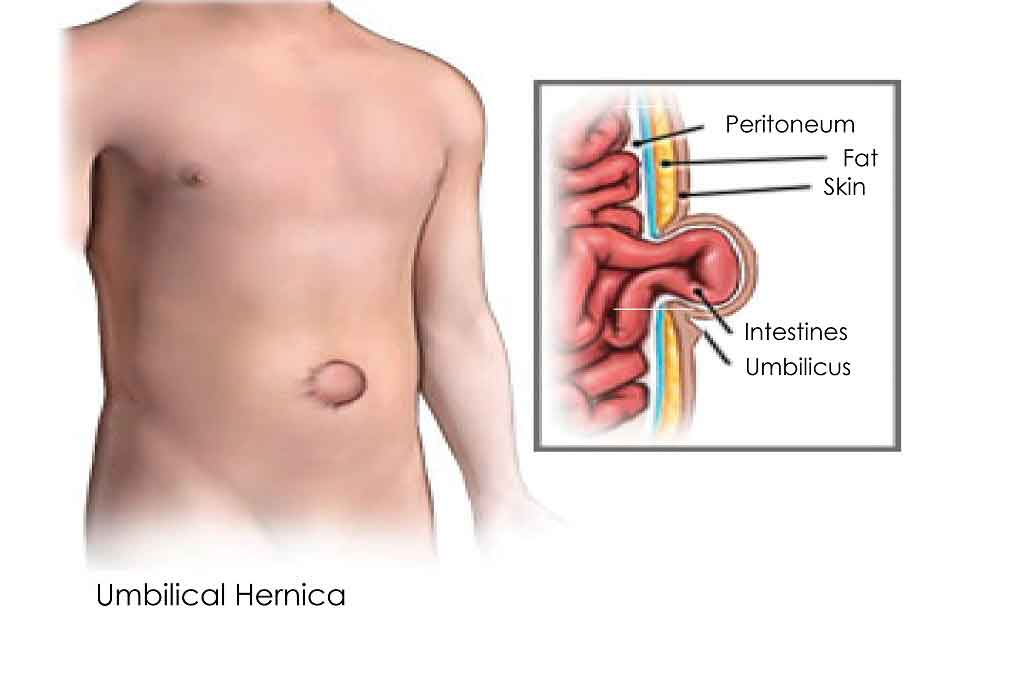Umbilical hernia repair
Introduction

A hernia occurs when an internal part of the body pushes through a weakness in the muscle or surrounding tissue wall.
Your muscles are usually strong and tight enough to keep your organs and intestines in place, but a hernia can develop if there are any weak spots.
What is an umbilical hernia?
Umbilical hernias are very commonin infants and young children, especially in babies born prematurely.
An umbilical hernia appears as a painless lump in or near the navel (belly button).
It may get bigger when laughing, coughing, crying or going to the toilet and may shrink when relaxing or lying down.
In many cases, the umbilical hernia goes back in and the muscles reseal before the child's first birthday.
Umbilical hernias can also develop in adults. Without treatment, the hernia will probably get worse over time.
For information on other typesof Hernia, femoral , see:
- inguinal hernia
- femoral hernia
- hiatus hernia
What causes an umbilical hernia?
During pregnancy, the umbilical cord passes through an opening in the baby's abdomen (tummy). This opening should close shortly after birth, but in some cases the muscles don't seal completely.
This leaves a weak spot in the surrounding muscle wall (abdominal wall). An umbilical hernia can develop when fatty tissue or a part of the bowel pokes through into an area near the navel.
In adults, factors that can contribute to developing an umbilical hernia include:
- being overweight or obese
- straining while moving or lifting heavy objects
- having a persistent heavy cough
- having a multiple pregnancy (such as twins or triplets)
When is surgery needed?
If necessary, umbilical hernias can be treated with surgery to push the bulge back into place and strengthen the weakness in the abdominal wall.
This operation may be recommended for your child if the hernia is large or hasn't disappeared by the time they reach four or five years old.
You'll usually be advised to wait for your child to reach this age because the operation isn't essential unless there are complications. The risk ofyour child developing complications is very low.
However, surgery is recommended for most adults with an umbilical hernia as the hernia is unlikely to get better by itself when you're older and the risk of complications is higher.
Complications that can develop as a result of anumbilical hernia include:
- obstruction where a section of the bowel becomes stuck outside the abdomen, causing nausea, vomiting and pain
- strangulation where a section of bowel becomes trapped and its blood supply is cut off; this requires emergency surgery within hours to release the trapped tissue and restore its blood supply so it doesn't die
Surgery will get rid of the hernia and prevent any serious complications, although there's a chance of it returning after the operation.
Repairing an umbilical hernia
An umbilical hernia repair is a relatively simple procedure that normally takes about 20 to 30 minutes to perform. General anaesthetic is usually used so there's no pain while the operation is carried out.
The weak spotin the abdominal wall is usually closed with stitches in children. If the hernia is large orin adults, a special mesh may be used to strengthen the area instead.
You or your child should be able to go home the same day the operation is carried out, but you may feel a bit sore and uncomfortable while you recover.
Strenuous activities will need to be limited for a few weeks after the operation, and a week or two off school or work is often advised. Most people are able to return to all their normal activities within a month of surgery.
-
recovering from an umbilical hernia repair
Are there any risks from surgery?
Complications from an umbilical hernia repair are uncommon, but can include:
- the wound becoming infected and needing antibiotics
- the hernia returning
- feeling sick and having a headache or numbness in the legs a few hours after the operation
The belly button often looks normal after surgery, but there's a chance its appearance may change as a result of the operation.
Introduction
A hernia occurs when an internal part of the body pushes through a weakness in the muscle or surrounding tissue wall. An umbilical hernia appears as a painless lump in or near the navel (belly button).
How is umbilical hernia repair carried out?
Umbilical hernia repair is a fairly quick and simple operation. It usually takes about 20 to 30 minutes and you or your child will usually be able to go home on the same day.
Recovering from umbilical hernia repair
You or your child will usually be able to go home the same day as having an umbilical hernia repair. It's normal to feel sore and uncomfortable immediately after surgery. There may be bruising and tenderness around the wound during your recovery at home.







 Subscribe
Subscribe Ask the doctor
Ask the doctor Rate this article
Rate this article Find products
Find products